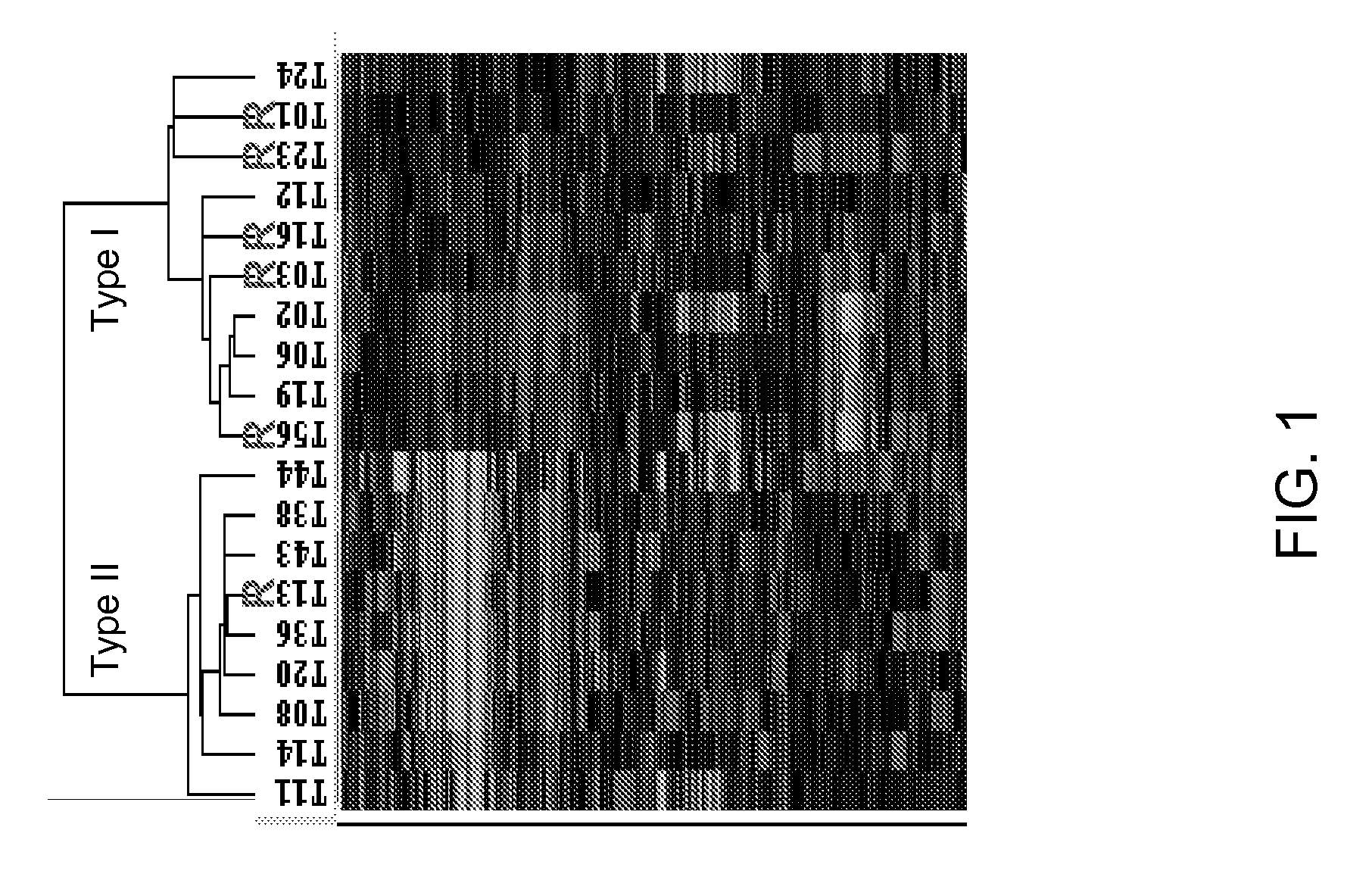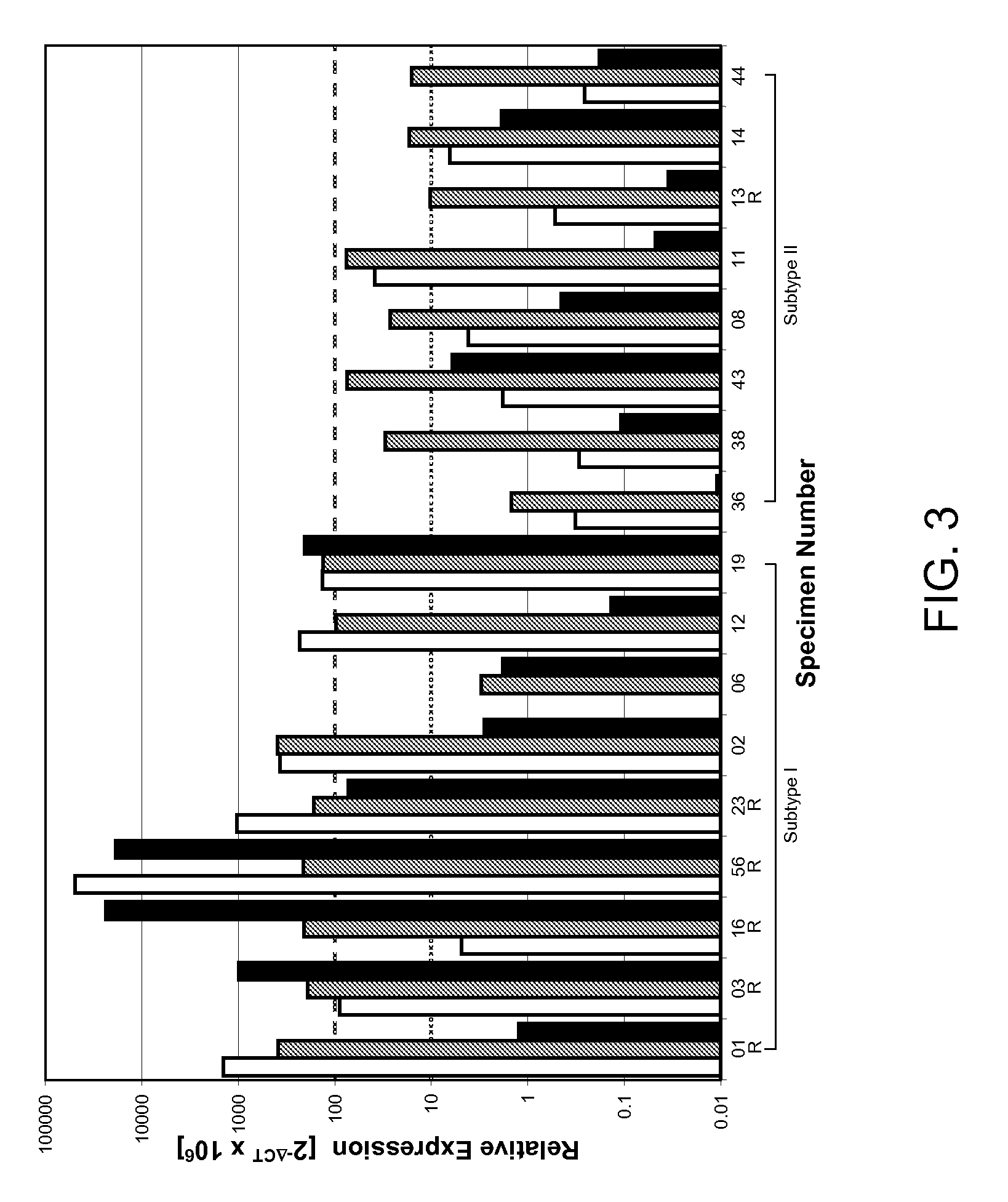Gene expression profiling of esophageal carcinomas
a technology of esophageal carcinoma and gene expression, applied in the field of cell biology, molecular biology, cancer biology, etc., can solve the problems that patients who are likely to have a pathcr cannot be predicted by pretreatment clinical parameters, and the role of preoperative ctxrt remains controversial
- Summary
- Abstract
- Description
- Claims
- Application Information
AI Technical Summary
Benefits of technology
Problems solved by technology
Method used
Image
Examples
example 1
Exemplary Materials and Methods for Example 2
[0083]The present invention concerns exemplary materials and methods that may be used in at least certain embodiments of the invention.
Patient Selection and Evaluation
[0084]All patients in this report participated in a clinical trial approved by the Institutional Review Board. Patients with localized histologically confirmed squamous cell carcinoma (SCCA) or ACA of the thoracic esophagus were considered eligible. Patients were evaluated by chest radiograph, computerized tomography of the chest and abdomen, upper gastrointestinal double-contrast barium radiographs, an esophago-gastro-duodenoscopy with endoscopic ultrasonography (EUS), electrocardiogram, SMA-12, electrolytes, complete blood count including platelet count, and serum baseline carcinoembryonic antigen (CEA) level. Positron emission tomography (PET) was performed when available. Patients with T2-3 with any N, patients with M1a cancer (celiac nodes associated with a GEJ carcinom...
example 2
Gene Expression Profiling
[0105]Patient characteristics are described in Table 1.
[0106]GEJ—Gastroesophageal Junction
[0107]PathCR was observed in 32% (6 / 19) cancers. Approximately four hundred genes were differentially expressed between the two subtypes with an estimated false discovery rate of 5%. Unsupervised hierarchical cluster analysis based on these genes segregated the cancers into two major categories, each consisting of 10 and 9 cancers respectively (FIG. 1). The molecular subtype I consisted 7 ACAs and 2 SCCAs and 1 ASCCA, while subtype II consisted only ACAs. Thus, ACAs segregated into two categories. It is worth noting that the segregation of ACAs into two subtypes remained same when two of SCCAs were excluded from the clustering analysis (data not shown). Five of the cancers with pathCR (4 / 5 ACA and 1 / 1 SCCA) clustered together in type I. Subtype II, with one exception consisted cancers with <pathCR. The clustering pattern was robust against the gene filtering process and...
example 3
Exemplary Materials and Methods for Example 4
[0116]The present example provides exemplary materials and methods for use in certain embodiments in the invention.
Patient Selection and Evaluation
[0117]Nineteen patients, including 16 from a previous report (Luthra et al., 2006), with localized, histologically confirmed adenocarcinoma of the thoracic esophagus were included in the study. All 19 patients participated in a clinical trial approved by The University of Texas M. D. Anderson Cancer Center's Institutional Review Board. Patients with tumors classified as T2-3 with any N, patients with Mia cancer (celiac nodes associated with a gastroesophageal junction carcinoma), and patients with T1N1 carcinoma were considered eligible. All patients were evaluated prior to registration by a multidisciplinary team that included thoracic oncology surgeons, radiation oncologists, gastroenterologists, and medical oncologists. To be eligible, patients had to have cancer that was considered technica...
PUM
| Property | Measurement | Unit |
|---|---|---|
| temperature | aaaaa | aaaaa |
| ionic strength | aaaaa | aaaaa |
| temperature | aaaaa | aaaaa |
Abstract
Description
Claims
Application Information
 Login to View More
Login to View More - R&D
- Intellectual Property
- Life Sciences
- Materials
- Tech Scout
- Unparalleled Data Quality
- Higher Quality Content
- 60% Fewer Hallucinations
Browse by: Latest US Patents, China's latest patents, Technical Efficacy Thesaurus, Application Domain, Technology Topic, Popular Technical Reports.
© 2025 PatSnap. All rights reserved.Legal|Privacy policy|Modern Slavery Act Transparency Statement|Sitemap|About US| Contact US: help@patsnap.com



